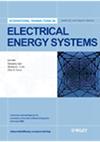Reactive power planning with voltage stability enhancement using covariance matrix adapted evolution strategy
引用次数: 14
Abstract
This paper presents the application of Covariance matrix adapted evolution strategy (CMAES) to reactive power planning (RPP) problem by minimizing the combined total cost of energy loss and the allocation cost of additional reactive power sources. Voltage stability index (L-index) is considered as an additional constraint in order to include the system stability into account. To improve the search efficiency of CMAES, penalty parameter-less scheme is employed for constraint handling. To determine the performance of the CMAES method on reactive power planning problem, IEEE-30 bus test system and Tamil Nadu Electricity Board (TNEB)-69 bus system (a practical system in India) are taken. For comparison purposes, the results of real-coded GA (RGA), particle swarm optimization (PSO), sequential quadratic programming (SQP), and Broyden–Fletcher–Goldfarb–Shanno (BFGS) methods are considered. The simulation results reveal that the CMAES algorithm performs better in terms of energy cost, investment cost, and consistency in getting optimal solution. Karush–Kuhn–Tucker (KKT) conditions are also applied on the best solution obtained using CMAES algorithm to substantiate a claim on optimality. Copyright © 2010 John Wiley & Sons, Ltd.基于协方差矩阵自适应进化策略的电压稳定性增强无功规划
将协方差矩阵自适应进化策略(CMAES)应用于无功规划(RPP)问题,以最小化总能量损失成本和附加无功源分配成本。电压稳定指数(L-index)被认为是一个附加的约束,以便将系统的稳定性考虑在内。为了提高CMAES的搜索效率,采用无惩罚参数的方法进行约束处理。为了确定CMAES方法在无功规划问题上的性能,以IEEE-30母线测试系统和泰米尔纳德邦电力委员会(TNEB)-69母线系统(印度的一个实际系统)为例进行了研究。为了比较,考虑了实编码遗传算法(RGA)、粒子群优化算法(PSO)、顺序二次规划算法(SQP)和BFGS算法的结果。仿真结果表明,CMAES算法在获得最优解的能量成本、投资成本和一致性方面具有更好的性能。并将KKT条件应用于CMAES算法得到的最优解,证明了该算法的最优性。版权所有©2010 John Wiley & Sons, Ltd
本文章由计算机程序翻译,如有差异,请以英文原文为准。
求助全文
约1分钟内获得全文
求助全文

 求助内容:
求助内容: 应助结果提醒方式:
应助结果提醒方式:


